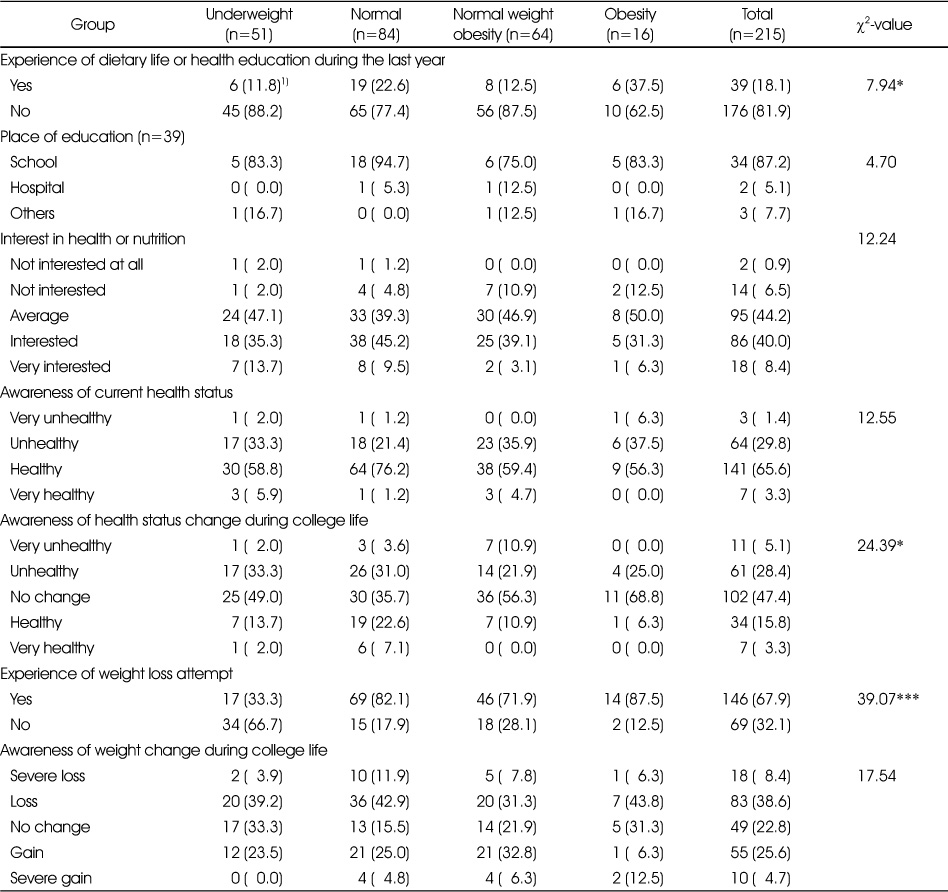Articles
- Page Path
- HOME > Korean J Community Nutr > Volume 23(5); 2018 > Article
-
Research Article
- Comparison of Dietary Behaviors and Blood Clinical Indices in Underweight, Normal Weight, Normal Weight Obese and Obese Female College Students
-
Su Bin Lee, Jung Hee Kim

-
Korean Journal of Community Nutrition 2018;23(5):431-443.
DOI: https://doi.org/10.5720/kjcn.2018.23.5.431
Published online: October 31, 2018
1Graduate School of Seoul Women's University, Seoul, Korea, Student.
2Department of Food and Nutrition, Seoul Women's University, Seoul, Korea, Professor.
- Corresponding author: Jung Hee Kim. Department of Food and Nutrition, College of Natural Sciences, Seoul Women's University, 621 Hwarangno, Nowon-gu, Seoul 139-774, Korea. Tel: (02) 970-5646, Fax: (02) 976-4049, jheekim@swu.ac.kr
Copyright © 2018 The Korean Society of Community Nutrition
This is an Open-Access article distributed under the terms of the Creative Commons Attribution Non-Commercial License (http://creativecommons.org/licenses/by-nc/3.0/) which permits unrestricted non-commercial use, distribution, and reproduction in any medium, provided the original work is properly cited.
- 1,100 Views
- 6 Download
- 2 Crossref
Figure & Data
REFERENCES
Citations

- A study on the perception of hand washing and health status in Korean adults
Soohee Park
Medicine.2021; 100(3): e24421. CrossRef - Gender Differences and Relationships among Lifestyle and Reproductive Health in University Students
Ju-Hee Nho, Hee Sun Kim
Korean Journal of Women Health Nursing.2019; 25(4): 446. CrossRef
Anthropometric indices of subjects
Underweight: BMI < 18.5 kg/m2, Normal: 18.5 kg/m2 ≤ BMI < 25 kg/m2, body fat percentage < 30%
Normal weight obesity: 18.5 kg/m2 ≤ BMI < 25 kg/m2, body fat percentage ≥ 30%, Obesity: BMI ≥ 25 kg/m2
1) Mean ± SD
a, b, c, d: Means with different superscript letters are significantly different at p<0.05 among 4 groups by ANOVA and Duncan's multiple range test
Interest in health and weight loss of subjects
Underweight: BMI < 18.5 kg/m2, Normal: 18.5 kg/m2 ≤ BMI < 25 kg/m2, body fat percentage < 30%
Normal weight obesity: 18.5 kg/m2 ≤ BMI < 25 kg/m2, body fat percentage ≥ 30%, Obesity: BMI ≥ 25 kg/m2
1) Number of subjects, ( ): % of subjects
*: Significantly different at p<0.05 by chi-square test
Dietary behaviors of subjects
Underweight: BMI < 18.5 kg/m2, Normal: 18.5 kg/m2 ≤ BMI < 25 kg/m2, body fat percentage < 30%
Normal weight obesity: 18.5 kg/m2 ≤ BMI < 25 kg/m2, body fat percentage ≥ 30%, Obesity: BMI ≥ 25 kg/m2
1) Mean ± SD
2) Number of subjects, ( ): % of subjects
*, ***: Significantly different at p<0.05, p<0.001 by chi-square test
Food consumption frequency of subjects
Underweight: BMI < 18.5 kg/m2, Normal: 18.5 kg/m2 ≤ BMI < 25 kg/m2, body fat percentage < 30%
Normal weight obesity: 18.5 kg/m2 ≤ BMI < 25 kg/m2, body fat percentage ≥ 30%,Obesity: BMI ≥ 25 kg/m2
1) Number of subjects, ( ): % of subjects ,**: Significantly different at p<0.01 by chi-square test
Serum clinical indices of subjects
Underweight: BMI < 18.5 kg/m2, Normal: 18.5 kg/m2 ≤ BMI < 25 kg/m2, body fat percentage < 30%
Normal weight obesity: 18.5 kg/m2 ≤ BMI < 25 kg/m2, body fat percentage ≥ 30%, Obesity: BMI ≥ 25 kg/m2
1) Mean ± SD
a, b C: Means with different superscript letters are significantly different at p<0.05 among 4 groups by ANOVA and Duncan's multiple range test
Underweight: BMI < 18.5 kg/m2, Normal: 18.5 kg/m2 ≤ BMI < 25 kg/m2, body fat percentage < 30% Normal weight obesity: 18.5 kg/m2 ≤ BMI < 25 kg/m2, body fat percentage ≥ 30%, Obesity: BMI ≥ 25 kg/m2 1) Mean ± SD a, b, c, d: Means with different superscript letters are significantly different at p<0.05 among 4 groups by ANOVA and Duncan's multiple range test
Underweight: BMI < 18.5 kg/m2, Normal: 18.5 kg/m2 ≤ BMI < 25 kg/m2, body fat percentage < 30% Normal weight obesity: 18.5 kg/m2 ≤ BMI < 25 kg/m2, body fat percentage ≥ 30%, Obesity: BMI ≥ 25 kg/m2 1) Number of subjects, ( ): % of subjects *: Significantly different at p<0.05 by chi-square test
Underweight: BMI < 18.5 kg/m2, Normal: 18.5 kg/m2 ≤ BMI < 25 kg/m2, body fat percentage < 30% Normal weight obesity: 18.5 kg/m2 ≤ BMI < 25 kg/m2, body fat percentage ≥ 30%, Obesity: BMI ≥ 25 kg/m2 1) Mean ± SD 2) Number of subjects, ( ): % of subjects *, ***: Significantly different at p<0.05, p<0.001 by chi-square test
Underweight: BMI < 18.5 kg/m2, Normal: 18.5 kg/m2 ≤ BMI < 25 kg/m2, body fat percentage < 30% Normal weight obesity: 18.5 kg/m2 ≤ BMI < 25 kg/m2, body fat percentage ≥ 30%,Obesity: BMI ≥ 25 kg/m2 1) Number of subjects, ( ): % of subjects ,**: Significantly different at p<0.01 by chi-square test
Underweight: BMI < 18.5 kg/m2, Normal: 18.5 kg/m2 ≤ BMI < 25 kg/m2, body fat percentage < 30% Normal weight obesity: 18.5 kg/m2 ≤ BMI < 25 kg/m2, body fat percentage ≥ 30%, Obesity: BMI ≥ 25 kg/m2 1) Mean ± SD a, b C: Means with different superscript letters are significantly different at p<0.05 among 4 groups by ANOVA and Duncan's multiple range test

 KSCN
KSCN





 Cite
Cite


